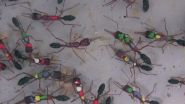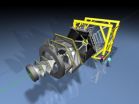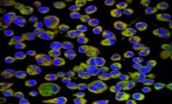(Press-News.org) Plasma technology based on Dielectric Barrier Discharge (DBD) has been widely demonstrated to be a novel active flow control method. In order to make the plasma flow control technology more practical, the plasma authority must be improved at high wind speed. Dr. ZHANG Xin and his group from School of Aeronautic, Northwestern Polytechnical University set out to tackle this problem. After 2-years of innovative research, they have developed a novel plasma actuator to improve the plasma authority at high wind speed. They found that the novel plasma actuator acting on the surface of UAV could obviously suppress the boundary layer separation and reduce the model vibration at the wind speed of 100 m/s. Their study expanded the plasma actuator authority and demonstrated an important role of plasma actuator in the real application. Their work, entitled "Unmanned air vehicle flow separation control using dielectric barrier discharge plasma at high wind speed", was published in SCIENCE CHINA Physics, Mechanics & Astronomy. 2014, Vol 57(6).
Plasma flow control technology based on DBD has been widely demonstrated to be a novel active flow control method for boundary layer control, lift augmentation and separation control. Compared with the traditional active flow control, the plasma flow control has simple structure without moving parts and is convenient for real time control due to its fast response. Many researchers have engaged in the study of plasma flow control. However, in the existing literature, the wind speeds of stall separation control on three-dimensional aerial vehicle using DBD plasma actuator so far were no more than 50 m/s, but the flow speed of real flight is generally above 100 m/s. Therefore, in order to make the plasma flow control technology more practical, the plasma authority must be improved at higher wind speeds.
This work explored the aerodynamic control using novel plasma on a UAV at high wind speeds. The results indicated that the novel plasma actuator was not only jet actuator but also vortex generator, as shown in Figure 1. It can create relatively large-scale disturbances in the separated wake shear layer and promote momentum exchange between low speed and high speed regions which lead to shear layer separation delay. It was found that the maximum lift coefficient of the UAV was increased by 2.5% and the lift/drag ratio was increased by about 80% at the wind speed of 100 m/s. This study demonstrated an important role of plasma actuator in the real application.
INFORMATION:
This research project was partially supported by the Exploration Foundation of Weapon Systems. It is an important breakthrough in the recent history of the study of plasma flow control. Future research will focus on flight verification testing for the UAV and on the effects of atmospheric parameters, including atmospheric pressure, temperature, and particularly air humidity.
See the article:
Zhang X, Huang Y, Wang W B, et al. Unmanned air vehicle flow separation control using dielectric barrier discharge plasma at high wind speed. SCI CHINA Phys Mech Astron, 2014 Vol. 57 (6): 1160-1168
http://phys.scichina.com:8083/sciGe/EN/abstract/abstract508799.shtml
Science China Press Co., Ltd. (SCP) is a scientific journal publishing company of the Chinese Academy of Sciences (CAS). For 60 years, SCP takes its mission to present to the world the best achievements by Chinese scientists on various fields of natural sciences researches.
http://www.scichina.com/
Unmanned air vehicle flow separation control using dielectric barrier discharge plasma at high wind
2014-05-12
ELSE PRESS RELEASES FROM THIS DATE:
Dopamine turns worker ants into warrior queens
2014-05-12
VIDEO:
When an H. saltator colony's queen dies, the female workers engage in ritual fights to establish dominance. Ultimately, a small group of workers establishes dominance and become a cadre of...
Click here for more information.
The ritualized fighting behavior of one ant species is linked to increases in dopamine levels that trigger dramatic physical changes in the ants without affecting their DNA, according to research from North Carolina State University, Arizona State ...
Major breakthrough in understanding Prader-Willi Syndrome, a parental imprinting disorder
2014-05-12
Scientists at the Hebrew University of Jerusalem have reported a major breakthrough in understanding the molecular basis for Prader-Willi syndrome (PWS), perhaps the most studied among the class of diseases that involves defects in parental imprinting.
The work, described in the latest online edition of the prestigious journal Nature Genetics, was led by Prof. Nissim Benvenisty, the Herbert Cohn Professor of Cancer Research and director of the Stem Cell Unit at the Alexander Silberman Institute of Life Sciences at the Hebrew University; and his PhD student Yonatan Stelzer. ...
Hijacking bacteria's natural defenses to trap and reveal pathogens
2014-05-12
The breakthrough, published in the journal Nature Materials, could offer an easier way of detecting pathogenic bacteria outside of a clinical setting and could be particularly important for the developing world, where access to more sophisticated laboratory techniques is often limited.
The research was led by Professor Cameron Alexander, Head of the Division of Drug Delivery and Tissue Engineering and EPSRC Leadership Fellow in the University's School of Pharmacy, building on work by PhD student Peter Magennis. Professor Alexander said: "Essentially, we have hijacked ...
Revealed:Protein's role in preventing heart muscle growth leading to heart failure
2014-05-12
Cardiovascular disease remains the number one cause of death in the Western world, with heart failure representing the fastest-growing subclass over the past decade. The stage that precedes heart failure in a significant number of cardiovascular diseases is pathological hypertrophy — the growth of the heart muscle in an attempt to increase its output.
Not all hypertrophy is pathological; for example, during pregnancy or high physical exertion, the muscle of the heart grows but myocardial function remains normal. But when hypertrophy is excessive, prolonged and unbalanced, ...
Link found between cell death and inflammatory disease
2014-05-12
A team of Melbourne researchers has shown a recently discovered type of cell death called necroptosis could be the underlying cause of inflammatory disease.
The research team discovered that a previously identified molecule involved in necroptosis, called RIPK1, was essential for survival by preventing uncontrolled inflammation. This finding could lead to future treatments for inflammatory diseases including Crohn's disease, rheumatoid arthritis and psoriasis.
The researchers, from the Walter and Eliza Hall Institute, also discovered that the 'survival' molecule RIPK1 ...
HADES searches for dark matter
2014-05-12
Although Dark Energy and Dark Matter appear to constitute over 95 percent of the universe, nobody knows of which particles they are made up. Astrophysicists now crossed one potential Dark Matter candidate – the Dark Photon or U boson – off the list in top position. This is the result of recent HADES experiments, where researchers from the Helmholtz-Zentrum Dresden-Rossendorf (HZDR) and from 17 other European institutes try to pin down the nature of Dark Matter. These negative results – recently published in Physics Letters B – could even lead to challenges of the Standard ...
Artificial magnetic bacteria 'turn' food into natural drugs
2014-05-12
Scientists from the University of Granada have successfully created magnetic bacteria that could be added to foodstuffs and could, after ingestion, help diagnose diseases of the digestive system like stomach cancer. These important findings constitute the first use of a food as a natural drug and aid in diagnosing an illness, anywhere in the world.
The researchers—members of Bionanomet, the Metallic Bionanoparticle research group of the Department of Inorganic Chemistry and the Institute of Biotechnology of the University of Granada—have conducted this research in collaboration ...
Recombinant adenovirus-mediated 3β-hydroxysteroid-Δ24 reductase inhibits neural apoptosis
2014-05-12
3β-Hydroxysteroid-Δ24 reductase (DHCR24) is a multifunctional enzyme that localizes to the endoplasmic reticulum and has neuroprotective and cholesterol-synthesizing activities. DHCR24 overexpression confers neuroprotection against apoptosis caused by amyloid β deposition. Dr. Xiuli Lu and colleagues from Liaoning University in China constructed two recombinant adenoviruses (Ad-rSYN1-DHCR24-myc and Ad-hSYN1-DHCR24-
myc) that drive DHCR24 expression specifically in neuronal cells. They also found that adenovirus transfection inhibits apoptosis through scavenging ...
Endocrine disruptors impair human sperm function
2014-05-12
HEIDELBERG, 12 May 2014 – A plethora of endocrine-disrupting chemicals interfere with human sperm function in a way that may have a negative impact on fertilization. These are the findings of a German - Danish team of researchers from the Center of Advanced European Studies and Research in Bonn, Germany, and the University Department of Growth and Reproduction, Rigshospitalet, Copenhagen, Denmark. The work, which is published in EMBO reports, suggests that endocrine disruptors may contribute to widespread fertility problems in the Western world in a way that hitherto has ...
Ultra-fast, the bionic arm can catch objects on the fly
2014-05-12
With its palm open, the robot is completely motionless. A split second later, it suddenly unwinds and catches all sorts of flying objects thrown in its direction -a tennis racket, a ball, a bottle-. This arm measures about 1.5 meters long and keeps an upright position. It has three joints and a sophisticated hand with four fingers. It was programmed at the Learning Algorithms and Systems Laboratory at EPFL (LASA) and designed to test robotic solutions for capturing moving objects. It is unique, as it has the ability to catch projectiles of various irregular shapes in less ...






